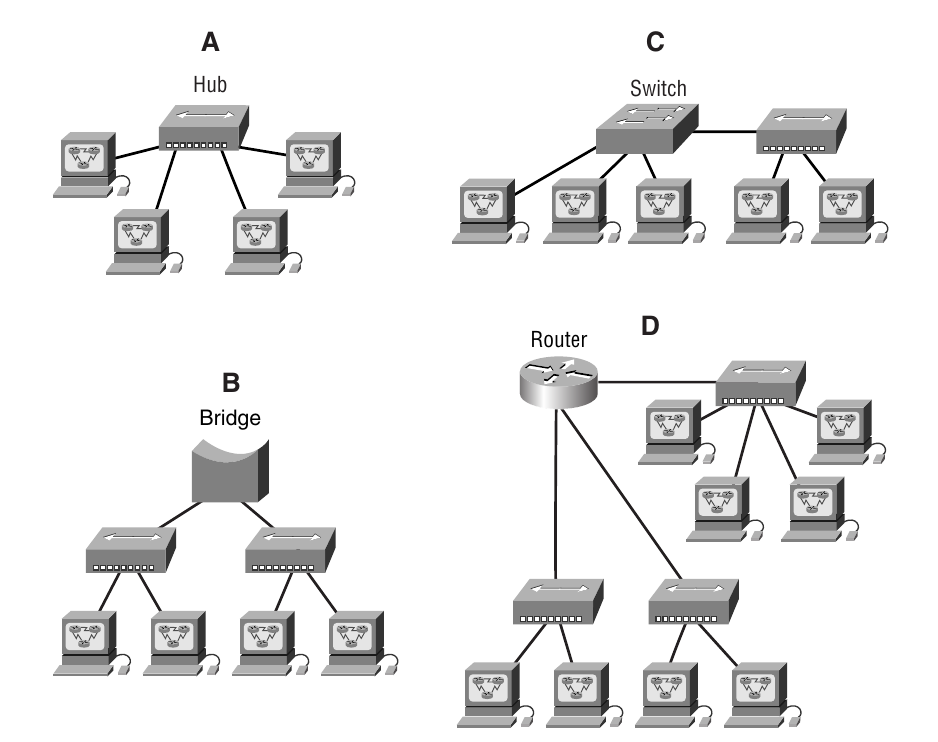My answer: Transport layer
Lab answer: The Application layer is responsible for finding the network resources broadcast from a server and adding flow control and error control (if the application developer chooses).
That felt misleading... I feel like the Application layer's purpose can vary from protocol to protocol, and some of the things in the question doesn't always happen in all protocols. I mean, if you're sending UDP packets through the Internet, then data integrity, coordination, etc. isn't really ensured? Although this is mentioned in the study guide: "The Application layer is also responsible for identifying and establishing the availability of the intended communication partner, and determining whether sufficient resources for the intended communication exist."
My answer: Physical layer
Lab answer: The Physical layer takes frames from the Data Link layer and encodes the ones and zeros into a digital signal for transmission on the network medium.
My answer: Network layer
Lab answer: The Network layer provides routing through an internetwork and logical addressing.
My answer: Presentation layer
Lab answer: The Presentation layer makes sure that data is in a readable format for the Application layer.
My answer: Session layer
Lab answer: The Session layer sets up, maintains, and terminates sessions between applications
My answer: Data Link
Lab answer: PDUs at the Data Link layer are called frames. As soon as you see “frame” in a question, you know the answer.
My answer: Transport layer
Lab answer: The Transport layer uses virtual circuits to create a reliable connection between two hosts.
My answer: Network layer
Lab answer: The Network layer provides logical addressing, typically IP addressing and routing.
My answer: Physical layer
Lab answer: The Physical layer is responsible for the electrical and mechanical connections between devices.
My answer: Data Link layer
Lab answer: The Data Link layer is responsible for the framing of data packets.
My answer: Application layer
Lab answer: The Session layer creates sessions between different hosts' applications.
I guess that makes sense: "Session layer basically keeps different applications' data separate from other applications' data."
My answer: Data Link layer
Lab answer: The Data Link layer frames packets received from the network layer.
My answer: Transport layer
Lab answer: The Transport layer segments user data.
My answer: Network layer
Lab answer: The Network layer creates packets out of segments handed down from the Transport layer.
My answer: Physical layer
Lab answer: The Physical layer is responsible for transporting ones and zeros in a digital signal.
My answer: Bits [ Frame [ Packet [ Segment ] ] ]
Lab answer: Segments, packets, frames, bits
My answer: Transport layer
Lab answer: Transport
My answer: Data Link
Lab answer: Data Link
My answer: Network layer
Lab answer: Network
My answer: It's 48 bit address.
The first 24 bytes are the organizationally unique identifier. It's usually the organization that manufactured the NIC, the IEEE issues one to them.
Bit 47 (I/G): 0 means it belongs to a real manufacturer, 1 means you can assume its broadcast or multicast
Bit 46 (G/L or U/L): 0 means the address was globally administered, 1 means it was locally administered
Remaining 22 bits of 24: Identifies the organization
The last 24 bits identify the card and are assigned by the organization making the NIC
Lab answer: 48 bits (6 bytes) expressed as a hexadecimal number
So That's what they mean by expression form... huh
My answer: Router
Lab answer: Router
My answer: Transport layer
Lab answer: Transport
My answer: Data Link (802.2 SNAP and SAP)
Lab answer: Data Link (LLC sublayer)
My answer: Switch
Lab answer: Bridge or Switch
My answer: Data Link
Lab answer: Data Link AND Physical
Should have seen the 's' on layers. I thought they only meant one.
My answer: Data Link AND Transport layer
Lab answer: Transport
Not a fan of this question because Data Link DOES do that at the LLC sublayer (The LLC can also provide flow control and sequencing of control bits.)
My answer: Router
Lab answer: Router
My answer: Network layer
Lab answer: Network
My answer: Data Link
Lab answer: Data Link (MAC sublayer)
My answer: Hub
Lab answer: Hub
My answer: Switch
Lab answer: Switch or Bridge
My answer: Router
Lab answer: Router

My answer: 1 Collision Domain, 1 Broadcast Domain
Lab answer: Hub: One collision domain, one broadcast domain
My answer: 2 Collision Domains, 1 Broadcast Domain
Lab answer: Bridge: Two collision domains, one broadcast domain
My answer: 4 Collision Domains, 1 Broadcast Domain
Lab answer: Switch: Four collision domains, one broadcast domain
My answer: 3 Collision Domains, 3 Broadcast Domains
Lab answer: Router: Three collision domains, three broadcast domains